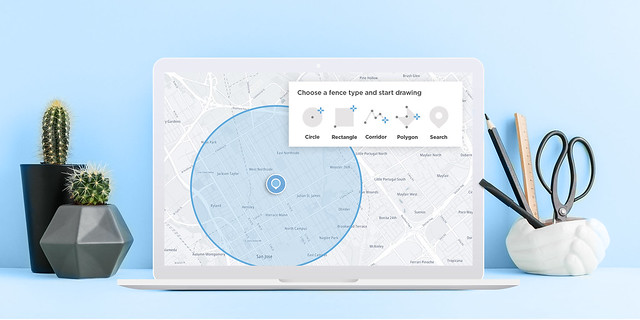Create a Geomarketing Mobile Application Using TomTom Geofencing
)

Geomarketing adds new marketing capabilities to your applications. In this article, we’ll look at how geofencing enables you to select a specific target area, learn about the traffic in, out, and within the geofenced area, and use the information to add to your users’ experience.
Marketing was initially based on casting a wide net. Technology has enabled its focus to narrow to more targeted and effective marketing efforts. Geomarketing, or geofence marketing, is a form of targeted marketing that uses location to determine and engage prospective customers.
In this article we'll take a look at what geofencing is, how it works, and some potential geomarketing applications for developers using geofences.
What is Geofencing?
A geofence is a virtual boundary around the geographic location or an area. It can be a circle or polygon around a user's location, or a corridor, which allows you to fence an entire road. This is useful if you want to find out when a driver veers off a route. The geofence may be defined by the distance from a certain point.
Geofencing can provide critical location-based capabilities for developers creating marketing-based applications. It lets them identify points of interest (POI) within a geofenced area. A POI is a dedicated location entity, landmark, or waypoint that one might find useful or interesting. Based on set of parameters, the developer can pick and choose which POIs and their characteristics (e.g. opening times, addresses etc) to highlight. Placing a POI and its characteristics on a map makes it discoverable via search or other mapping application features.
A geofence, using location services from a smartphone, for example, can recognize when objects or potential customers cross in or out of a specified boundary, when smartphone users allow an application permission to access their location in real time. This information allows you to act based on changing locations within a target geographic market.
Geofences groups thousands of location data points for customers. You can create a geofence around neighborhoods, shopping districts, and sales territories, or even "near my shop." This information enables capabilities from cross-marketing to routing, and identifies POIs near a location.

How Geofencing Works
With TomTom's Geofences Creator API, an application that helps you to create geofences using the TomTom Geofencing API, you select a point or area on the map, and use the API to place a geofence around it. The point can be a single point of interest, the location of a package or vehicle, or even an entire area like a city street, park, or shopping center. The API gives you the flexibility to create different shapes of geofences. These include circles, polygons, and rectangles, and you can even create a corridor—a customizable border-width along a roadway. For example, you could take a highway and create a geofence that identifies services within a half mile, or mark out the dimensions of a street fair.
With location technology available on mobile phones, you can track every time a user enters or leaves a geofence boundary. This information can be used to trigger actions or notifications (via the Notifications API) to indicate that a customer is near services, such as a gas station or fast-food restaurant. These notifications could also include coupons or other marketing materials.
The data collected on locations (with customer permission) enables marketing analytics, such as traffic going past a given location. It could also help marketers understand the percent of potential customers who pass a shopping area and enter. This information could be used to identify business opportunities, test marketing effectiveness, or set rental rates.
It should be noted that the information collected for marketing purposes is de-identified. Any personal confidential information (PCI) is removed from the data stream that’s collected. TomTom uses location data only after making sure the information is not directly linkable to an individual.
Various techniques are applied to protect identity, such as encryption and temporary random identifiers to prevent location details from being easily linked back to a given device. Within 24 hours of a user shutting down a device or app, TomTom automatically and irreversibly erases any data they hold that could re-identify the device. The company doesn't know where you’ve been and can't tell anyone, even if forced. It never links location data to a TomTom account or any other information that identifies you directly.
Applications of Geomarketing
Let’s look at some of the applications of geomarketing. One potential use is tracking movements around a store or shopping center.
In a shopping mall, for example, potential customers pass any number of stores. While foot traffic is interesting, more critical is the question of how many people actually enter a given store. This can be taken a step further to evaluate the effectiveness of window displays, advertising, and sales. From a marketing standpoint, it would be useful to know if giving a buy-one-get-one-free offer increases store traffic or the purchase of non-sale items. And the data can also be used for A/B test marketing. Foot traffic through a store or mall can influence the placement of kiosks for maximum exposure.
Also, a situation that customers find particularly frustrating is having to wait for assistance. Location data can tell store managers in real time which store areas are busy, allowing the manager to dispatch more personnel to an area. This data also helps a store manager plan staffing.
Geomarketing can use geofences to enable webhooks to send relevant messages to smartphone users who enter a predetermined boundary or geographic area. In a resort area, for example, a visitor might want to know what POIs are nearby during a walk or drive. Webhooks could let a mobile application send the visitor messages about POIs they’ve selected in the application when they cross a geofenced boundary.

Available Now
Everything discussed in this piece is available as a service today, without any investment in hardware or infrastructure of any kind, through TomTom. Easy-to-use APIs allow you to obtain and integrate geofencing solutions into your current applications with just a few lines of code.
In TomTom’s Geofencing API Documentation, you’ll find all the information you need, plus sample implementation code, with detailed guidance and tutorials. The Geofences Creator application helps you to create and edit geofences using the TomTom Geofencing API. You can register for a key to access and try all of these APIs at the TomTom Developer Portal. See for yourself how easily this software-only solution can be implemented on smartphones or other devices.
Above all, TomTom values and respects your privacy and that of the customers using TomTom services within the applications you create. You have complete control of your data and can delete information permanently in the Location History API, making it impossible for TomTom to provide this data to anyone.
Next Steps
Geomarketing adds new marketing capabilities to your applications. Geofencing enables you to select a specific target area, learn about the traffic in, out, and within the geofenced area, and use the information to add to your users’ experience. Marketing actions can take the form of alerts with special offers or helping a manager deploy customer service personnel. Understanding the flow of foot or vehicle traffic in and around a geofenced area can help place kiosks and other services for maximum effectiveness without compromising user privacy.
For more articles on geofencing, read these related articles:
- What is Geofencing?
- Getting Started with the TomTom Geofencing Service
- Putting the TomTom Location History and Geofencing APIs to Work
To try the Geofencing API for yourself, check out the Geofencing API documentation here and register for a free API key today on our developer portal.
Happy mapping!